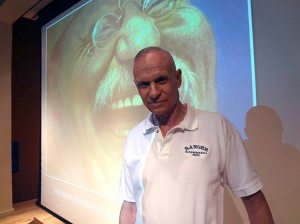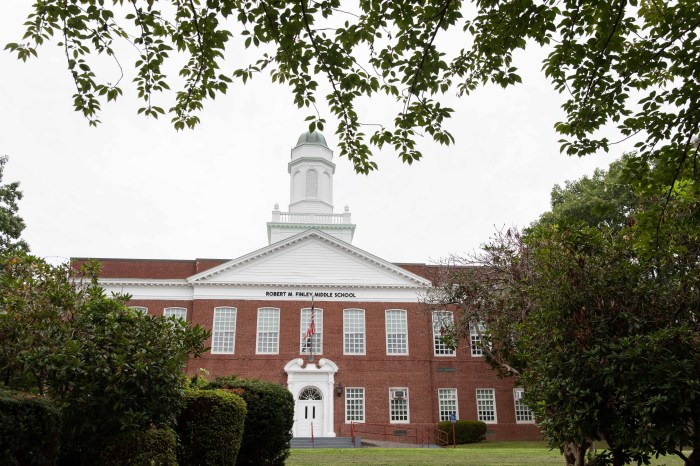
Sagamore Hill, the famed Cove Neck landmark home of Theodore Roosevelt, is officially back open for business after the completion of a comprehensive $10 million renovation and the staff there are anxious tell anyone who will listen all about it.
To that end, Howard Ehrlich, a senior federal ranger at what is now known as The Sagamore Hill National Historic Site, recently held a seminar at the Syosset Public Library (in an ongoing series throughout Long Island) on the life and times of the 26th President of the United States and his time in Sagamore Hill, his beautiful Queen Anne-style home originally constructed in 1886, where Roosevelt lived until his death in 1919.
“This is to get word out to people about the re-opening now that the renovation is complete,” he said. “At these lectures, we give a little history of Theodore Roosevelt—one of the most popular presidents in history—with special emphasis on his life here at Sagamore Hill. We go over his life, we discuss the history of Sagamore Hill and cover several of the rooms within.”
Sagamore Hill held it’s grand re-opening for VIPs on July 12 (with for the general public on July 13), and according to Ehrlich, Long Islanders have been clamoring to check out the renovations first-hand at this most historic of landmarks.
 “It was incredible, just incredible. There were waves of people, many of them students brought in by bus,” he said. “They all went up to the house. There were speeches and it was wonderful. I actually gave the very first tour. And on Monday, there were lines waiting to get into the visitor center. It was incredible.”
“It was incredible, just incredible. There were waves of people, many of them students brought in by bus,” he said. “They all went up to the house. There were speeches and it was wonderful. I actually gave the very first tour. And on Monday, there were lines waiting to get into the visitor center. It was incredible.”
The extensive renovations, which strived to preserve as much of the original structure as possible while providing vital updates to things like the plumbing, electrical wiring and more, have so far been very well received by the public, Ehrlich noted.
“It’s brighter. The paint has been cleaned, the wallpaper’s been cleaned and it’s quite nice. They did a great job,” he said. “If you saw the house three years ago and again today, you wouldn’t even notice that anything was changed.”
One of the VIPs that Ehrlich said he showed around was Bill O’Reilly of Fox News’ The O’Reilly Factor, who gave his tour guide quite the ego-boosting shout-out on his program the next day.
“On Monday, I watched the program to see if he said anything,” he said. “In the last five minutes, he talks about Sagamore Hill and shows some great shots of the various rooms and then he says, ‘If you get a chance to have a tour with Howard Ehrlich, you’ll be very happy.’ I thought that was very nice.”
As part of his lecture, Ehrlich elaborated upon some of the more noteworthy rooms in Sagamore Hill and one of the more interesting areas within it, he said, was what was affectionately known by Roosevelt—himself an avid hunter—as “The Gun Room.”
“That is where he actually tested rifles out of the window…aiming away from the road, of course,” he said. “Roosevelt was an expert marksman and one time when the Secretary of State came to visit, he heard the gunfire going off and said, ‘Oh, that damn cowboy’s at it again!’”
One especially impressive feature that visitors to Sagamore Hill can get to see up close and personal is Roosevelt’s telephone. The very first of it’s kind ever made available to any U.S. President, it enabled him to actually communicate with Washington D.C. directly, giving the house it’s reputation as the first true “Summer White House.”
Before the phone was installed in Sagamore Hill, Ehrlich noted—unbelievably—that Roosevelt was forced to relay messages to and from the nation’s capital in an entirely different manner.
“Before that, the only phone around was in the drug store in town,” he said. “When he needed to get a message to someone, he would send a kid—the son of the drug store owner—on a bicycle with messages to and from town to Sagamore Hill, all day long. At the end of the day, Roosevelt would tip him one time for the entire day. But the ironic thing was, the drug store closed at 6 p.m. From then until morning, the President was incommunicado.”
As a stop-gap measure, a woman was hired to man the phone in the drug store through midnight until Roosevelt finally—and historically—had his own phone installed in his home.
“Even though Roosevelt may have been born in New York City, he was truly ‘The President from Long Island,’” Ehrlich said.
To find out more about Sagamore Hill and to plan a visit, go to www.nps.gov/sahi/index.htm.


































